Bali: The Ocean
We began our stay in Bali at a beach community on the east coast, which is lined by a 1.5 lane road. Here’s what the ocean looks like from the hotel:
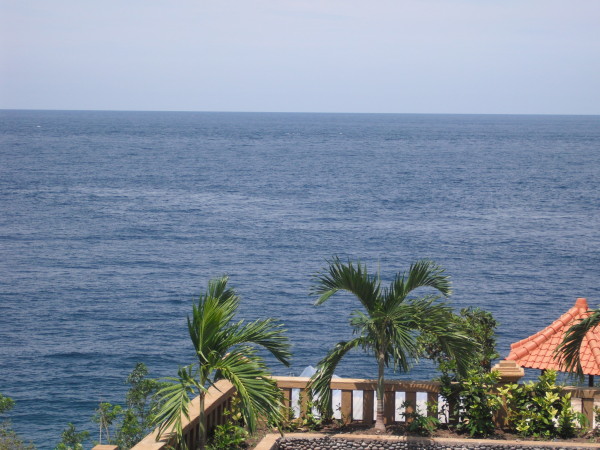 Or, if you look from almost any other place on a hill amidst the greenery, like this:
Or, if you look from almost any other place on a hill amidst the greenery, like this:
It’s blue, it’s clear, it’s fairly warm, and makes for wonderful snorkeling – although not quite as warm as the waters around Malaysia, since it is, after all, a whole 8 degrees away from the Equator. But from Singapore, that 8 degrees makes all the difference between an insufferably stuffy climate and one that yields consistent refreshing breezes.
We visited during the rainy season, so it wasn’t always clear and blue. But it was always interesting. Here’s the beach adjacent to our hotel, from our veranda:
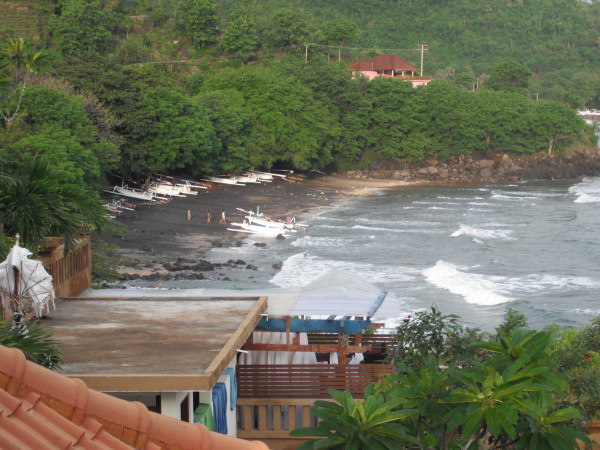 Those black volcanic rocks provide a nice anchor for coral polyps; you can wade and see corals and fish about 10 feet in. If you get beyond the surf breaks there are piles of corals and caves, and all kinds of interesting things to watch. If you’re like me you spend a lot of time chasing fish and checking periodically that you’re still within sight of familiar land. If you’re like my spouse, you can take a break from snorkeling and chat with local people on the beach, about fishing, religion, family, and other stuff. You can rent snorkel gear from people who live in grass-thatched houses behind those boats, and you can buy little model boats from them as well.
Those black volcanic rocks provide a nice anchor for coral polyps; you can wade and see corals and fish about 10 feet in. If you get beyond the surf breaks there are piles of corals and caves, and all kinds of interesting things to watch. If you’re like me you spend a lot of time chasing fish and checking periodically that you’re still within sight of familiar land. If you’re like my spouse, you can take a break from snorkeling and chat with local people on the beach, about fishing, religion, family, and other stuff. You can rent snorkel gear from people who live in grass-thatched houses behind those boats, and you can buy little model boats from them as well.
If you want a more structured snorkel experience, you can visit the Japanese wreck from World War II. You may be able to spot the bouy marking it, about a fourth in from the left, in the picture below:
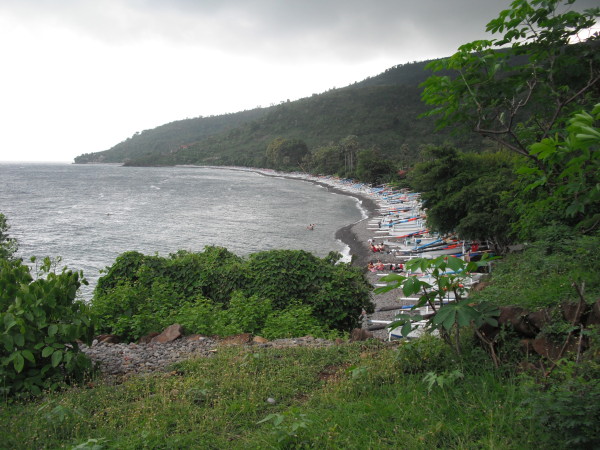 There’s an actual snorkel gear renting hut down there to the right of the boats, and you can get a snorkel guide or a diving guide to lead you through all the great stuff underwater. We didn’t this time, but maybe will some other. The coral in this area is extraordinarily varied and colorful, and the fish life likewise. I forgot to put sunscreen behind my ears and was so entranced in my fish-chasing that I got badly burned there.
There’s an actual snorkel gear renting hut down there to the right of the boats, and you can get a snorkel guide or a diving guide to lead you through all the great stuff underwater. We didn’t this time, but maybe will some other. The coral in this area is extraordinarily varied and colorful, and the fish life likewise. I forgot to put sunscreen behind my ears and was so entranced in my fish-chasing that I got badly burned there.
The Japanese wreck is very accessible to unguided swimmers, and it’s dramatic – full of empty portholes with seaweed waving around in the current, big fish swimming into view from the depths, bubbles rising from the scuba divers below. The wreck is very close to the land, so I figured the Japanese sailors all made it to shore pretty easily. But my friend tells me that actually the shore is a lot closer to the wreck now than during the war; successive volcanic eruptions have increased the size of the island and brought the beach creeping towards the ship. Below is a picture of the steep volcanic cliff adjacent to this beach:
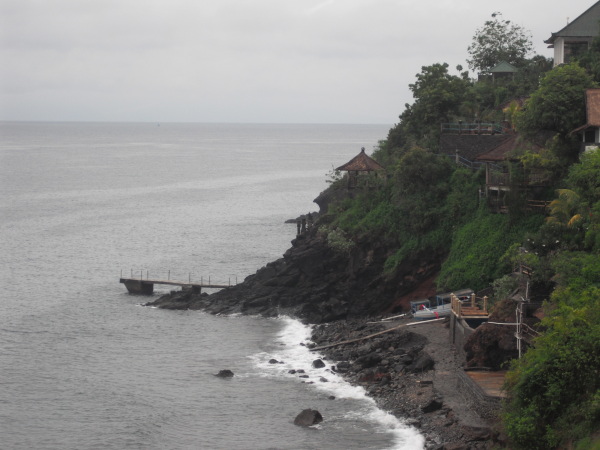 Hotels, temples and huts are built on this precipitous slope, cows and goats are grazed there, plants and gardens thrive there. But they’ll all be overwhelmed the next time the volcano blows, or maybe even in an earthquake before then. Meanwhile, the place is a fertile and beautiful lush land. Which brings us, sort of, to the topic of fishing:
Hotels, temples and huts are built on this precipitous slope, cows and goats are grazed there, plants and gardens thrive there. But they’ll all be overwhelmed the next time the volcano blows, or maybe even in an earthquake before then. Meanwhile, the place is a fertile and beautiful lush land. Which brings us, sort of, to the topic of fishing:
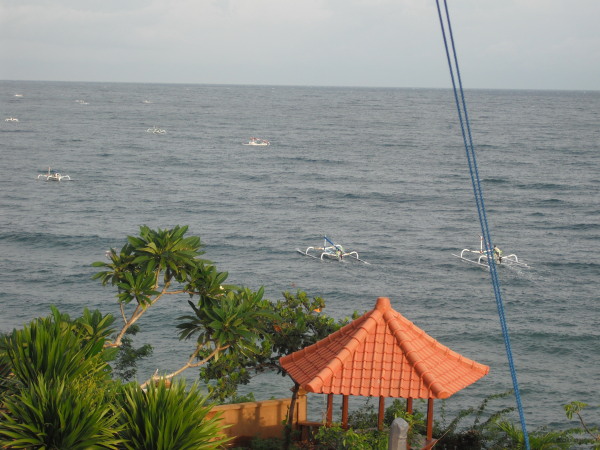 Those white spidery things are the local fishing boats. The men in the villages hop into these before dawn, use their power motors to go about a mile offshore, and cast their nets to catch tuna or whatever else they can. Then they put up their sails, which are held together between two long bamboo poles, and cruise home by 7 a.m., stopping some distance out to clean the fish and ensure that the guts don’t pollute the beaches. They sell their catch to the local markets and then rest before doing their other day jobs, like renting out snorkel gear, guiding tourists around the coral reefs or taking them out in their boats. Each boat can hold either two men and a lot of fishnets, or four tourists and a sailor. They are incredibly lightweight, so that instead of mooring them at docks the sailors just turn their heads towards the beach, gun the engines, and run up onto the sand – they can always just shove them back into the water later.
Those white spidery things are the local fishing boats. The men in the villages hop into these before dawn, use their power motors to go about a mile offshore, and cast their nets to catch tuna or whatever else they can. Then they put up their sails, which are held together between two long bamboo poles, and cruise home by 7 a.m., stopping some distance out to clean the fish and ensure that the guts don’t pollute the beaches. They sell their catch to the local markets and then rest before doing their other day jobs, like renting out snorkel gear, guiding tourists around the coral reefs or taking them out in their boats. Each boat can hold either two men and a lot of fishnets, or four tourists and a sailor. They are incredibly lightweight, so that instead of mooring them at docks the sailors just turn their heads towards the beach, gun the engines, and run up onto the sand – they can always just shove them back into the water later.
One man told me that sometimes he just goes for a walk in the mornings instead of fishing. “I have fished 17 years here, and the catch decreased by 70%. You used to get 400 fish in your net in the morning; now it’s 50, or maybe zero.” I think I saw an offshore factory ship off in the distance, so it’s no mystery, although it’s certainly a shame.
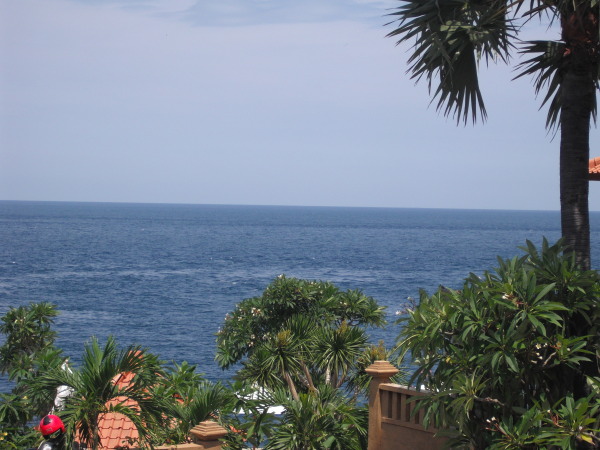
January 11th, 2011 at 12:48 pm
I would say your mystery plant in the first photo is something called Crown of Thorns. I think it’s one of the euphorbias (euphorbiae?)